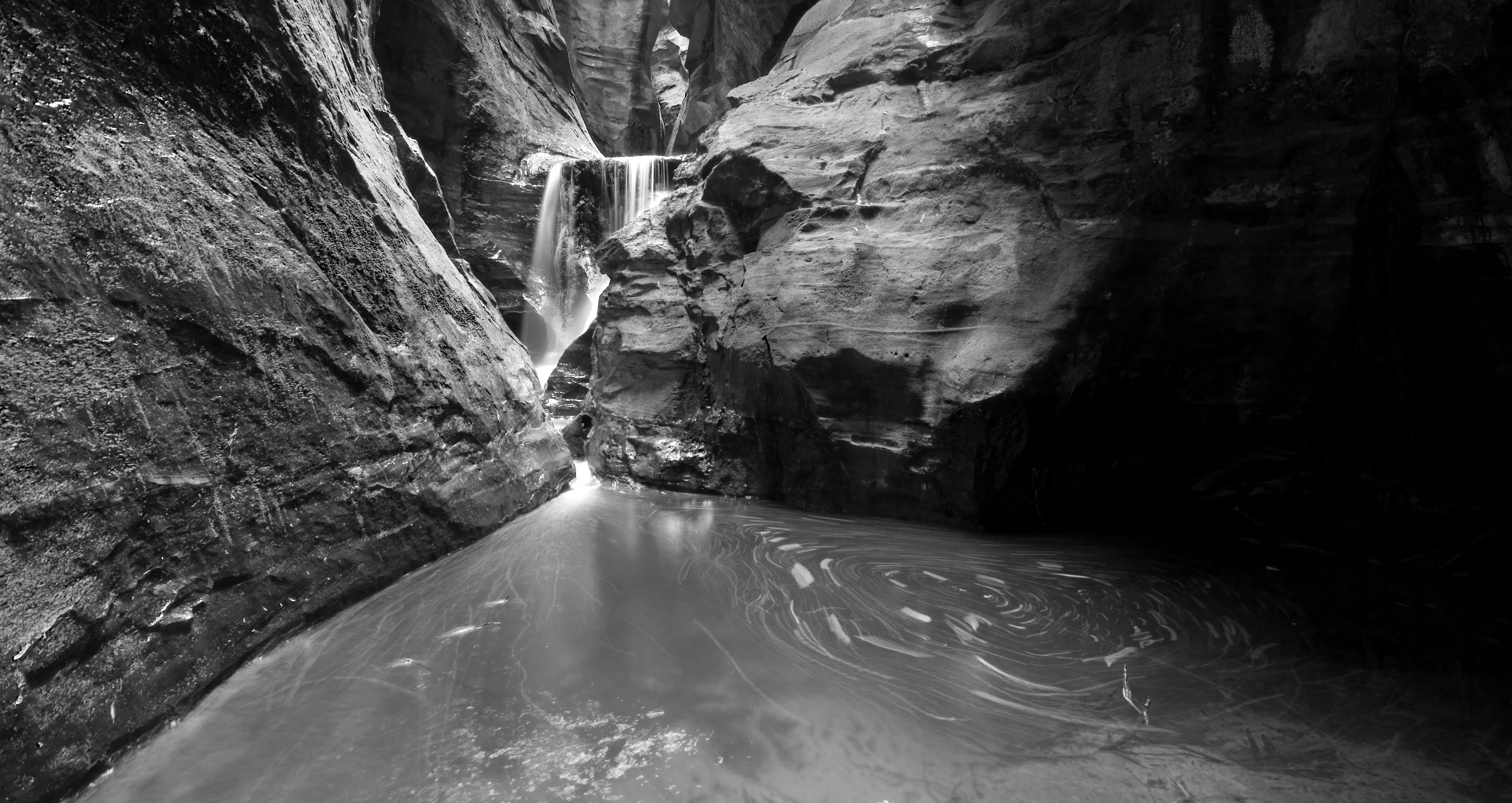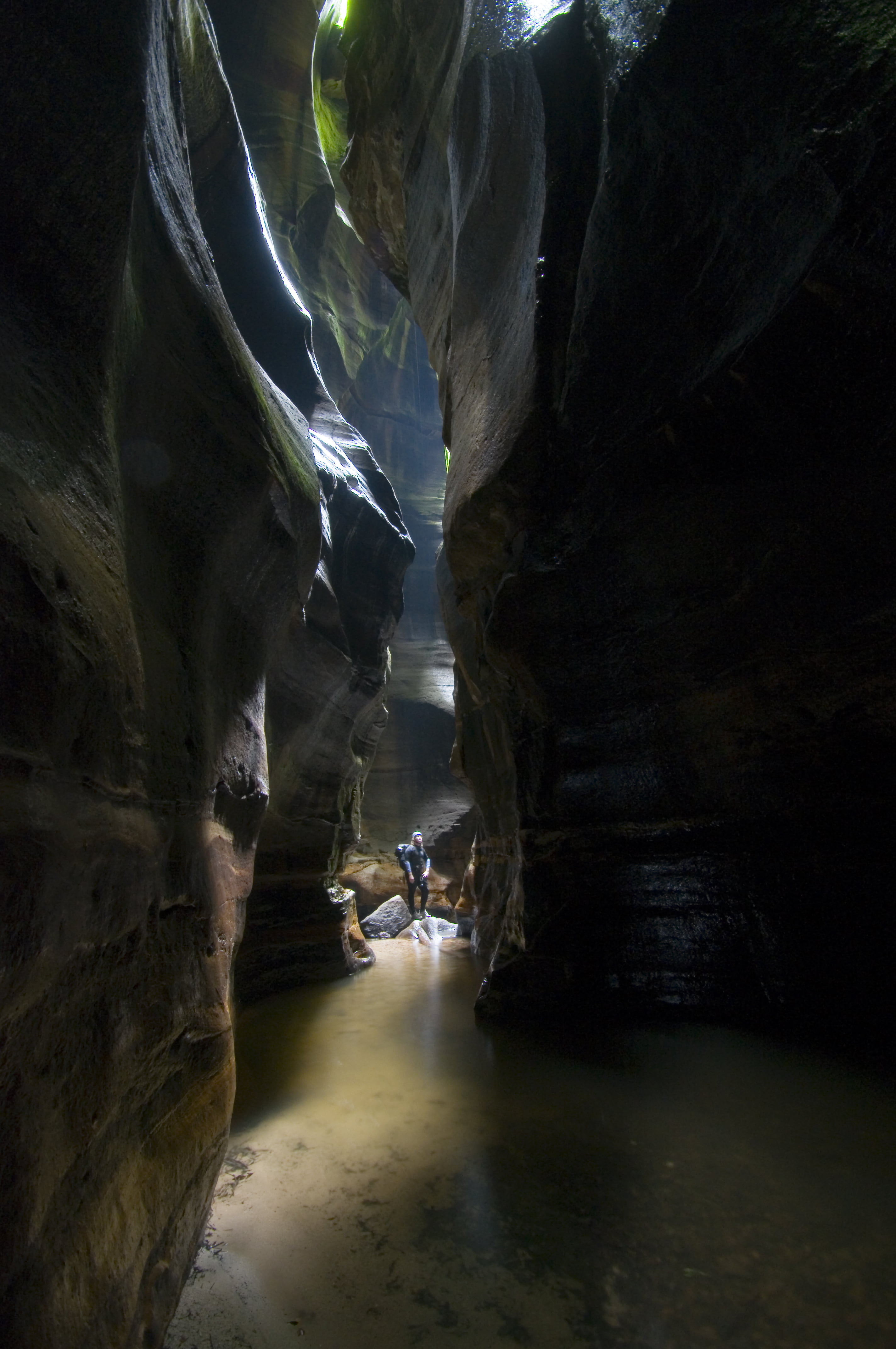“My machine becomes the locus of lament for how the world is. I grieve the futility of my society that necessitates subjugation and subsumption… I grieve the systems, beings and things, the waterways, hillsides, caves, ice, wind and fire that are my machine. I grieve also the slaughter, mayhem and madness that are my machine. And I grieve me – a loss of strength as weakness of arms steals through torso and clambers up neck; a loss of certainty in the choices I make for living right within this world. Who am I and how should I be within a home, a community and culture that are bound to the earth through machine?”
Excerpt from Capillary Shawl:
Place Matters: Finding Deep Ecology within Towns and Cities
By Kate Booth
I am in a world torn asunder, yet completely whole. In my mind I stand high on a sandstone escarpment overlooking the vast wilderness of the Wollemi. Below me snakes the twisted dark line of the canyon below. As I drop deeper and deeper into the canyon system, the musky smell of fern decay awakens my senses. Stony ground transferring to soft loam, rich in texture and fecundity; soil and space that time forgot. A silence permeates the air around me, broken only briefly by the piercing cries of lyrebird and bellbird, whose resounding echoes linger in the cliffs above. Like Earth pouring out Her soul, blood of the land, water arises from the sandy soil and begins the decent deep into the earth. Water cuts the rock, cascading into channels of stone and sending the spray of waterfalls into the depths. This is the source, the blood of the earth. Aqua causation forms my spiritual home. I stand now waist deep in water, in shadow of the mighty concave walls around me, deep within the canyon. Above me a thin strip of light, perforated by the luminous green of fern, sends a beam of light striking the wall in front of me, illuminating the water droplets falling from ferns like the internal fire of a diamond. I stand waist deep in water, the chill cramping my muscles and shocking my bones. I stand waist deep in water, the yabbies and the flat head fish scuttling and darting from my mass. I stand waist deep in water, absorbed by the awe of this cathedral of nature, pondering the profundity of space, time, and being. I am home. I am in a world torn asunder, yet completely whole.
I believe that my level of ecological awareness run deep. I also believe that I hold conflicting values as my actions in this world do not reflect my reflection on ‘how might I live’. I believe Paul in his address to the Romans in the Christian New Testament gives a vivid description on my personal feelings. “I don’t really understand myself, for I want to do what is right, but I don’t do it. Instead, I do what I hate. But if I know that what I am doing is wrong, this shows that I agree that the law is good. So I am not the one doing wrong; it is sin living in me that does it” (Romans 7:15-17, New Living Translation). While I do not agree with the outcome of Paul’s questioning, I believe that he eloquently voices the deep-level personal feelings I have for what I think is right and how my actions are a part of what I believe.
In an attempt to clarify my personal ecological thinking pattern I would like to bring the reader back within the realm of my spiritual home, the canyons in the Blue Mountains. I would like to bring the reader to focus on a short period of time and a narrow confine of space. I have just begun to rig up an abseil down a twenty metre waterfall. The abseil is what we would call the point of no return. Once I have committed to this abseil I cannot turn around and walk back to the car. If something goes wrong, such as a snake bite, hypothermia, or a broken bone or other injury there is no choice but to ‘press on regardless’. This part of the canyon is not naturally accessible to any animal that has not evolved within this system. If a wallaby or tigersnake falls into the canyon depths, death is certain. In that same token, without the human technological advancement in ropes, wet suits, and synthetic or natural fibres a human who managed to find themselves within the canyon, death would follow shortly. I find it ironic that the place that I find the most spiritual connection to earth is the very place that is least suited for my biological adaptation.
I would like to unpack the technological aspects of canyoning, with Kate Booth’s reference to the connection between herself and the machine, as given in the introduction. “I grieve the systems, beings and things, the waterways, hillsides, caves, ice, wind and fire that are my machine.” In her essay Capillary Shawl, Booth is exploring the connections between herself and her washing machine. Eccentric as this may sound, I find many correlations between her relationship with her washing machine and my own personal reflection on the technological items I utilize in canyoning. What is most poignant, for me, is thinking upon the interconnection between my gear, the very thing that facilitates canyoning, and myself. Take for example the device I use to lower myself down a rope known as a descender. A descender is a piece of equipment designed to be passed through the rope and attached to a harness worn by the user. This device is the most important piece of equipment as it provides the pivotal connection between myself and the rope. The descender creates friction with the rope in varying degrees most of them dependent on the user applying additional pressure between the rope and descender. In unpacking the technological connections between myself and my equipment, I would like the reader to imagine the causal chain in the production of my descender. My device is known as a Hydrobot. It is made in Italy. It is made of a combination of aluminium alloy, magnetised iron, steel, and some blue and black paint. I cannot know for certain of the material sequence and location in ‘place’, but I can imagine the following scenario. Bauxite ore is mined in Greece and smelted into alumina in Italy. Then through electrolysis alumina is transformed into aluminium. The aluminium is then alloyed with magnesium and zinc producing a high tensile strength product which can be casted into my descender. The descender non-aluminium parts are added and the finished product is shipped to Australia. The electricity needs to produce my descender can be imagined as ranging from nuclear power imported from France to Italy and coal powered plants in Italy. The uranium is sourced from Australia and the coal sourced from The United States. Oil used by the cargo ship, is extracted from Saudi Arabia, Indonesia, and Venezuela, and is refined into diesel in Egypt, India and China. The descender is shipped in a steel container owned by a company in Singapore and transported by a ship flying a German flag. On the descenders passage from Italy to Australia it passes through the international waters in close proximity to Antarctica. By the time I purchased my descender it can be causally linked to every continent on earth.
I use this example to illustrate the connections I see in the production and use of goods that I use to transport me to a place in which I can commune with what I understand as spiritual. The irony surpasses the superficial connection of myself and technology, and begins to emerge that my actions have impacts spanning the globe. I do not have to directly experience the political dictatorship in Venezuela to understand that my descender plays a role in people suffering. I do not have to directly experience the destruction of sensitive ecosystems in Greece to understand that my descender plays a role in exploitive strip mining. I do not have to directly experience the rising sea levels due to global warming to understand that my descender plays a role in swallowing entire villages in the South Pacific.
I do not actively feel guilt. Yet the deep reflection upon my actions, devices and consumption do take on the aspect of guilt at times. I do not have the answers to the problems I internally face. In the end I choose to go canyoning as a means to feel connection to something bigger than myself. As I said in my opening introduction, I am in a world torn asunder, yet completely whole.






Wow,
Fantastic images, thank you for sharing them Love the depth and colours..
Fascinating article, interesting thoughts must say.
Cheers
Frank
It’s amazing to go to see this web page and reading the views of all friends concerning this post,
while I am also eager of getting familiarity.